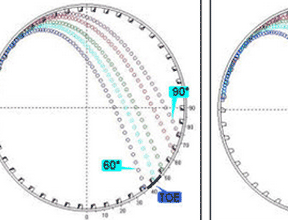Abstract
Authors:
Malcolm Powell, University of Cape Town
Ian Smit, Anglo Research
Peter Radziszewski, McGill University
Paul Cleary, CSIRO Mathematics and Information Sciences
Bruce Rattray, Castech Solutions
Klas-Goran Eriksson, Metso Minerals
Leon Schaeffer, Weir Rubber Engineering
ABSTRACT
Dramatic shortcomings of mill liner designs, especially of large SAG mills, - such as rapid failure and even mill shell damage arising from impacting of the charge directly on the liner, and unsuitable spacing of lifter bars yielding unfavourable compromises between lifter bar height and liner life - have highlighted the significance of correct mill liner selection. Liners protect the mill shell from wear and transfer energy to the grinding charge, and a careful balance is required to optimise these conflicting requirements. This review serves to highlight these problems and how they can be tackled in a logical and often inexpensive manner by considering charge trajectories and liner spacing criteria, in conjunction with liner wear monitoring.
An overview is given of the principal types and materials of construction of mill liners. Examples of good and bad liner design are given, followed by a rigorous approach to liner design based on the best technology available, combined with experience and logical engineering thinking.
Methods of monitoring the progressive wear of liners, and relating this to the performance of the mill are presented. The value of wear monitoring in ongoing liner optimisation and cost saving, through balancing the lives of the lifters and shell plates, and providing reliable comparative data for testing different liner materials and designs, is explained. Wear testing techniques and their drawbacks and limitations are discussed, along with new tests under development.
The contribution of advanced computation techniques, such as the Discrete Element Method (DEM), to predicting the wear profiles of liners, and integrating this information into optimising the overall performance of the mill from a production and cost perspective, are considered in some detail. This takes into account the change of the charge trajectories, energy transfer, and milling efficiency, as the mill liner wears and the profile changes.
It is hoped that this review will better arm mill operators to select suitable mill liners, with a view to decreasing production costs while maintaining mill performance near optimal levels.
Additional Information Citation
Powell, M.S., Smit, I., Radziszewski, P., Cleary, P., Rattray, B., Eriksson, K., Schaeffer, L. 2006. "The Selection and Design of Mill Liners. In Advances in Comminution", Ed. S.K. Kawatra. ISBN-13: 978-0-87335-246-8, Society for Mining, metallurgy, and exploration, Inc., Colorado, USA. pp. 331-376.
BibTex
@article{10.1109/ACV.1998.732850,
author = {Powell, M.S., Smit, I., Radziszewski, P., Cleary, P., Rattray, B., Eriksson, K., Schaeffer, L},
title = {The Selection and Design of Mill Liners. In Advances in Comminution},
year = {2006},
isbn = {978-0-87335-246-8},
pages = {331-376},
doi = {http://doi.ieeecomputersociety.org/10.1109/ACV.1998.732850},
publisher = {Society for Mining, metallurgy, and exploration},
address = {Colorado, USA},
